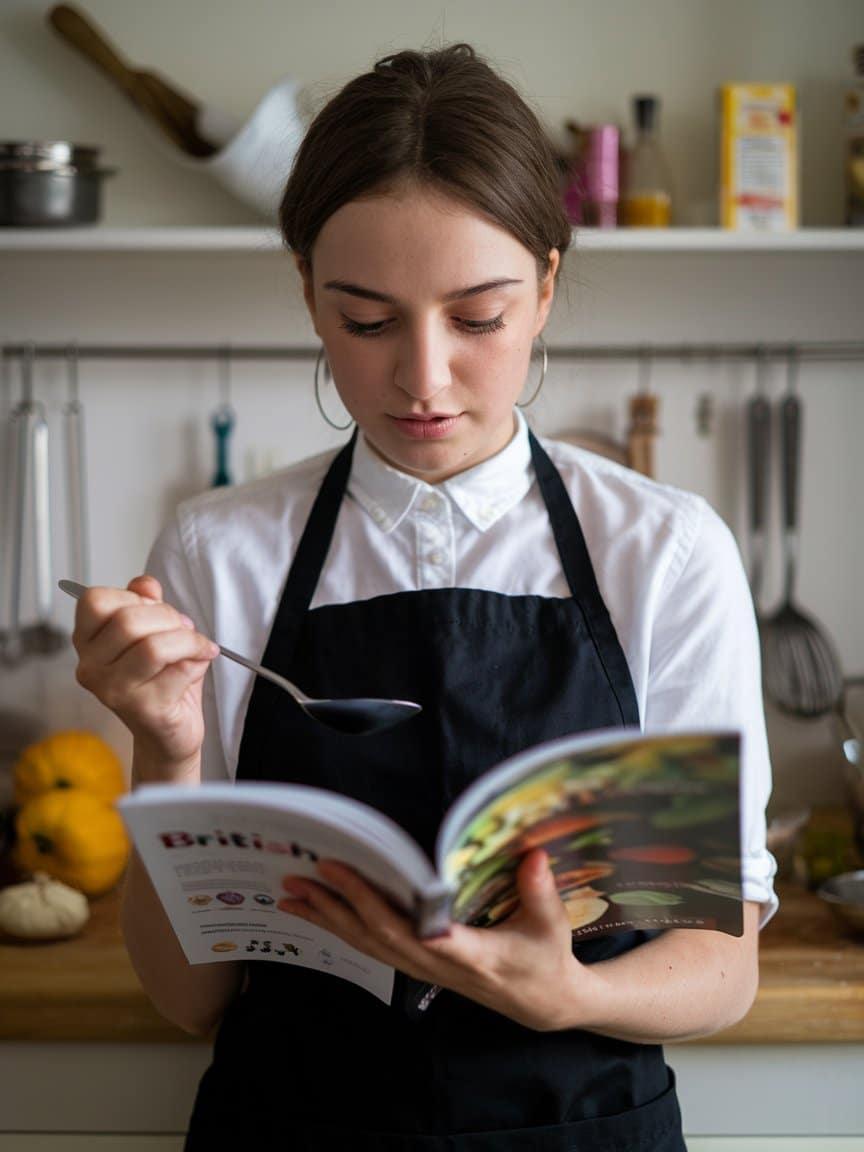I’ll never forget the first time I walked into my grandmother’s kitchen and caught a whiff of something absolutely divine simmering away in her old avocado-green slow cooker.
The aroma was rich, herbaceous, and somehow familiar yet completely mysterious at the same time. She’d been experimenting with what would become our family’s signature dish: creamy ranch slow-cooker pork chops that practically fall apart at the touch of a fork.
What makes this recipe truly special isn’t just the convenience factor though heaven knows we all need more of that in our busy lives. It’s the way the slow cooking process transforms ordinary pork chops into something transcendent.
The ranch seasoning doesn’t just sit on top like a garnish; it penetrates deep into the meat fibers, creating layers of flavor that you simply can’t achieve with traditional cooking methods.
This isn’t your typical “dump and go” slow cooker recipe, either. There’s actual technique involved here, subtle nuances that separate the good from the extraordinary.
The creamy sauce develops its own personality over the long cooking time, becoming something entirely different from its humble packet beginnings.
The Magic Behind the Method
Slow cooking pork chops might seem counterintuitive to some chefs who’ve been trained to fear overcooking this lean cut. But here’s the thing most people don’t realize: when you cook pork chops low and slow in a moist environment, the connective tissues break down gradually, creating natural gelatin that adds body and richness to the sauce. It’s the same principle that makes osso buco so incredibly tender, just applied to a more accessible cut of meat.
The ranch seasoning acts as both a flavor enhancer and a tenderizer. The buttermilk powder contains lactic acid, which gently breaks down proteins while the herbs and spices create a complex flavor profile that deepens during the extended cooking time. Most home cooks never give their seasonings enough time to fully develop, but eight hours in a slow cooker? That’s when the real magic happens.
Ingredients & Substitutions
For the Pork Chops:
- 6 bone-in pork chops (about 1-inch thick)
- 2 tablespoons olive oil
- 1 packet (1 oz) ranch dressing mix
- 1 packet (1 oz) onion soup mix
- 1 can (10.75 oz) cream of mushroom soup
- 8 oz cream cheese, softened
- 1/2 cup chicken broth
- 2 tablespoons fresh chives, chopped
- Salt and black pepper to taste
Optional Additions:
- 1 pound baby potatoes, halved
- 2 cups fresh green beans, trimmed
- 1 large onion, sliced
The beauty of this recipe lies in its flexibility, but let’s talk about making smart substitutions. If you’re dealing with dietary restrictions, you can swap the cream cheese for Greek yogurt mixed with a bit of cornstarch though you’ll loose some of that luxurious mouthfeel. For a lighter version, use cream of celery soup instead of mushroom, or try a homemade version using cauliflower puree as the base.
When selecting pork chops, thickness matters more than you might think. Thin chops will fall apart completely (which isn’t necessarily bad if you’re going for pulled pork vibes), while thick chops maintain their structure better. I prefer bone-in chops because the bone adds flavor and helps prevent the meat from drying out, even during extended cooking.
The ranch packet isn’t just about convenience it’s about consistency. Sure, you could make your own blend, but the commercial packets have been formulated specifically for even distribution and optimal flavor balance. That said, if you’re feeling adventurous, substitute with a homemade mix using dried dill, garlic powder, onion powder, and buttermilk powder.
Step-by-Step Instructions
Preparation Phase: Start by taking your cream cheese out of the fridge at least 30 minutes before cooking. Cold cream cheese won’t incorporate smoothly and you’ll end up with lumpy sauce a rookie mistake that’ll haunt your final presentation.

Season your pork chops generously with salt and pepper. This isn’t just about flavor; it’s about creating a proper foundation for the other seasonings to build upon. Don’t skip this step, even though you’re using seasoning packets later.
The Searing Step: Heat olive oil in a large skillet over medium-high heat. This is where many home cooks go wrong they either skip the searing entirely or they don’t get the pan hot enough. You want that oil to shimmer slightly, almost smoking but not quite.
Sear the pork chops for 2-3 minutes per side until golden brown. You’re not cooking them through at this stage; you’re building flavor through the Maillard reaction. Those caramelized bits on the surface will add incredible depth to your final dish.
Building the Sauce: In a mixing bowl, whisk together the softened cream cheese, cream of mushroom soup, ranch packet, and onion soup mix. The key here is patience whisk until completely smooth. Any lumps at this stage will remain lumps in your final sauce, and nobody wants that.
Gradually add the chicken broth while whisking. This step is crucial for achieving the right consistency. Too thick and your sauce won’t distribute evenly; too thin and you’ll end up with something more like flavored water than a proper sauce.
Assembly and Cooking: Place the seared pork chops in your slow cooker. Pour the sauce mixture over the top, making sure each chop is well-coated. If you’re adding vegetables, nestle them around the chops now potatoes on the bottom where they’ll cook more thoroughly, green beans on top where they’ll retain some texture.
Cook on low for 6-8 hours or high for 3-4 hours. The low and slow method produces superior results, allowing the flavors to meld and the meat to become incredibly tender. Resist the urge to lift the lid frequently; every peek releases steam and extends cooking time.
Cooking Techniques & Science
The science behind slow cooking is fascinating and often misunderstood. When you cook meat at low temperatures for extended periods, several things happen simultaneously. The collagen in the connective tissue begins to break down around 140°F, but it takes time hours, not minutes to fully convert to gelatin.

This gelatin doesn’t just tenderize the meat; it thickens the cooking liquid, creating a naturally rich sauce without the need for flour or other thickeners. The proteins in the meat also undergo a process called denaturation, where their structure unravels and becomes more digestible and flavorful.
The ranch seasoning undergoes its own transformation during the long cooking process. The dried herbs rehydrate and release their essential oils gradually, while the buttermilk powder creates a subtle tang that balances the richness of the cream cheese. It’s a slow dance of flavors that simply can’t be rushed.
Temperature control is critical here. Most slow cookers maintain temperatures between 200-300°F, which is perfect for breaking down tough fibers without drying out the meat. The moist environment prevents moisture loss, while the gentle heat ensures even cooking throughout.
Common Mistakes and How to Avoid Them
One of the biggest mistakes I see home cooks make is choosing the wrong cut of pork. Lean cuts like center-cut chops can become dry and tough if overcooked, while shoulder chops have enough fat and connective tissue to remain juicy throughout the long cooking process.
Another common error is not properly preparing the sauce base. Lumpy cream cheese will never smooth out during cooking it just creates an unappetizing texture that screams “amateur.” Take the time to whisk everything properly before adding it to the slow cooker.
Overcrowding the slow cooker is another pitfall. The chops need space for the heat to circulate properly. If you’re cooking for a crowd, it’s better to use two smaller slow cookers than to cram everything into one large one.
Variations and Creative Adaptations
Spicy Ranch Version: Add 1-2 teaspoons of cayenne pepper to the sauce mixture, or substitute pepper jack cheese for half of the cream cheese. The heat plays beautifully against the cooling effect of the ranch seasonings.
Herb-Crusted Variation: Mix panko breadcrumbs with fresh herbs and parmesan cheese. Sprinkle over the chops during the last 30 minutes of cooking for a textural contrast that elevates the entire dish.
Wine-Enhanced Version: Replace half the chicken broth with white wine. The alcohol cooks off during the long cooking process, leaving behind subtle fruit notes that complement the ranch flavors beautifully.
Vegetable-Heavy Adaptation: Add carrots, celery, and bell peppers for a one-pot meal that’s both satisfying and nutritious. The vegetables will take on the flavors of the sauce while maintaining their individual character.
Serving & Pairing Suggestions
The presentation of this dish can make or break the dining experience. While it’s tempting to just plop everything onto a plate, a little attention to plating goes a long way. Arrange the pork chops on warmed plates, spoon the creamy sauce around (not over) the meat, and garnish with fresh chives and a sprinkle of paprika for color contrast.

The creamy richness of this dish pairs beautifully with bright, acidic sides. A simple arugula salad with lemon vinaigrette cuts through the richness, while roasted Brussels sprouts with bacon add textural interest. For starch, consider garlic mashed potatoes or wild rice pilaf both absorb the sauce wonderfully without competing for attention.
Wine pairing can be tricky with ranch-based dishes, but a crisp Sauvignon Blanc or a light Pinot Grigio works surprisingly well. The acidity in these wines complements the herbs while cleansing the palate between bites. If you prefer red wine, go with something light like a Pinot Noir or Beaujolais.
Storage and Reheating
This dish actually improves with time, making it perfect for meal prep. Store leftovers in the refrigerator for up to 4 days, or freeze for up to 3 months. The sauce may separate slightly during storage, but a gentle stir while reheating will bring it back together.
When reheating, add a splash of chicken broth or milk to restore the proper consistency. Microwave reheating works fine for individual portions, but for larger quantities, use the stovetop over low heat to prevent scorching.
Conclusion
Creamy ranch slow-cooker pork chops represent everything that’s wonderful about comfort food cooking. They’re approachable enough for beginners yet sophisticated enough to impress guests. The technique is forgiving, the ingredients are accessible, and the results are consistently delicious.
The key to success lies in understanding that this isn’t just about throwing ingredients together it’s about building layers of flavor through proper technique and patience. From the initial searing to the final garnish, every step contributes to the overall experience.
Don’t be afraid to make this recipe your own. Cooking should be personal, and the best dishes are the ones that reflect your individual taste and creativity. Use this as a foundation, but feel free to experiment with different seasonings, vegetables, or cooking times until you find your perfect version.
Remember, the best comfort food isn’t just about filling bellies it’s about creating memories and bringing people together around the table. This dish does exactly that, turning an ordinary weeknight dinner into something special that your family will request again and again.
Frequently Asked Questions?
Q: Can I use boneless pork chops instead of bone-in?
A: Absolutely, though you’ll need to adjust the cooking time. Boneless chops cook faster and can become dry if overcooked. Reduce the cooking time to 4-6 hours on low or 2-3 hours on high. The bone-in variety provides more flavor and moisture, but boneless works perfectly fine if that’s what you have available.
Q: What if my sauce turns out too thick or too thin?
A: Consistency issues are easy to fix. If the sauce is too thick, gradually whisk in warm chicken broth until you reach the desired consistency. If it’s too thin, create a slurry by mixing 2 tablespoons of cornstarch with 2 tablespoons of cold water, then stir it into the sauce during the last 30 minutes of cooking.
Q: Can I prepare this recipe ahead of time?
A: Yes, this is excellent for meal prep. You can sear the chops and prepare the sauce mixture the night before, storing them separately in the refrigerator. In the morning, simply combine everything in the slow cooker and start cooking. The flavors actually develop better with this overnight resting period.
Q: Why did my pork chops turn out tough?
A: Tough pork chops usually result from cooking at too high a temperature or not cooking long enough. Pork needs time for the connective tissue to break down properly. If you’re using the high setting, try switching to low for a longer cooking time. Also, make sure you’re not lifting the lid too frequently, which releases steam and extends cooking time.
Q: Can I double this recipe for a larger crowd?
A: You can double the recipe, but you’ll need a large slow cooker (at least 6-quart capacity) or use two smaller ones. Don’t try to cram everything into a standard-sized slow cooker as the chops won’t cook evenly. When doubling, you may need to extend the cooking time slightly to ensure everything cooks through properly.

Veronica is a passionate food enthusiast with over three years of experience in exploring and writing about diverse cuisines. Her expertise lies in reviewing restaurants, sharing creative recipes, and discovering the latest food trends. As the voice behind FoodieRecap.com, Anju brings fresh perspectives and culinary insights to her audience.
